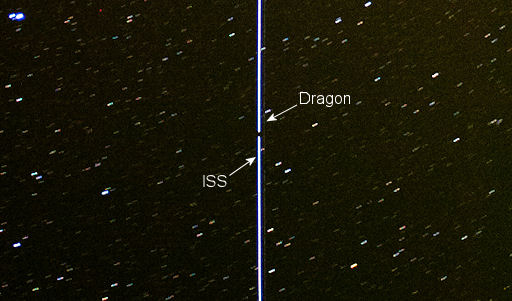They came from outer space--and you can have one! Genuine meteorites are now on sale in the Space Weather Store. | | |
CONTINUED QUIET: For the fourth day in a row, solar activity remains low. None of the sunspots on the Earthside of the sun pose a threat for strong flares. NOAA forecasters put the chances of an X-class eruption at less than 1%. Solar flare alerts: text, voice.
DRAGON RENDEZVOUS: SpaceX's Dragon spacecraft will rendezvous with the International Space Station (ISS) on Friday, May 25th, making it the first commercial spacecraft to dock with the ISS. Last night, Dave Blanchard photographed the Dragon chasing the space station across the night sky over Flagstaff, Arizona:

"While the ISS was very bright and clearly visible in this image, the Dragon was very dim," says Blanchard. "It can be seen as a faint streak just below the ISS."
The two streaks will soon be joined. During the early hours of May 25th, the Dragon will approach the docking port on the station's Harmony module. Because this is the Dragon's first visit to the ISS, mission controllers will proceed with caution. A detailed series of navigation and communication tests will be performed before the capsule is allowed to move close enough for astronauts to grab it with the robot arm and connect it to the station.
After docking, the Dragon will remain connected for about three weeks, giving astronauts plenty of time to unload its 1200 lb of supplies and re-load it with used scientific equipment for return to Earth. Reversing the process of connecting the spacecraft to the station, astronauts will use the robotic arm to remove the capsule. The Dragon will then de-orbit and return to Earth under parachutes, splashing down in the Pacific Ocean off the California coast.
Readers, are you ready to see the Dragon? Check Space Weather's Simple Satellite Tracker or your cellphone for a schedule of flybys over your location.
more images: from Alan Thomas of Central Otago, New Zealand; from Stephen & Matthew Lindner of Ann Arbor, Michigan;
ECLIPSE SUNBEAMS: For many observers, the best part of the May 20th solar eclipse is not what the Moon did to the sun, but rather what it did to the sunbeams. Gaps in clouds, leafy trees, and window shades cast pinhole images of the smiling crescent sun onto all kinds of happy surfaces:

"My daughter Antonia was sitting in just the right place," says Tino Hammid of Los Angeles, California. "The crescent images are created by small holes in the closed window blinds that act as a series of pinhole cameras."
Many more pictures of the eclipse--from the sun to sunbeams--may be found in our new realtime photo gallery. It's an experimental service, so feel free to report problems. Click on the link below and start exploring:
Space Weather Real Time Image Gallery
[Submit your photos] [NASA video: Solar Eclipse over the USA]

